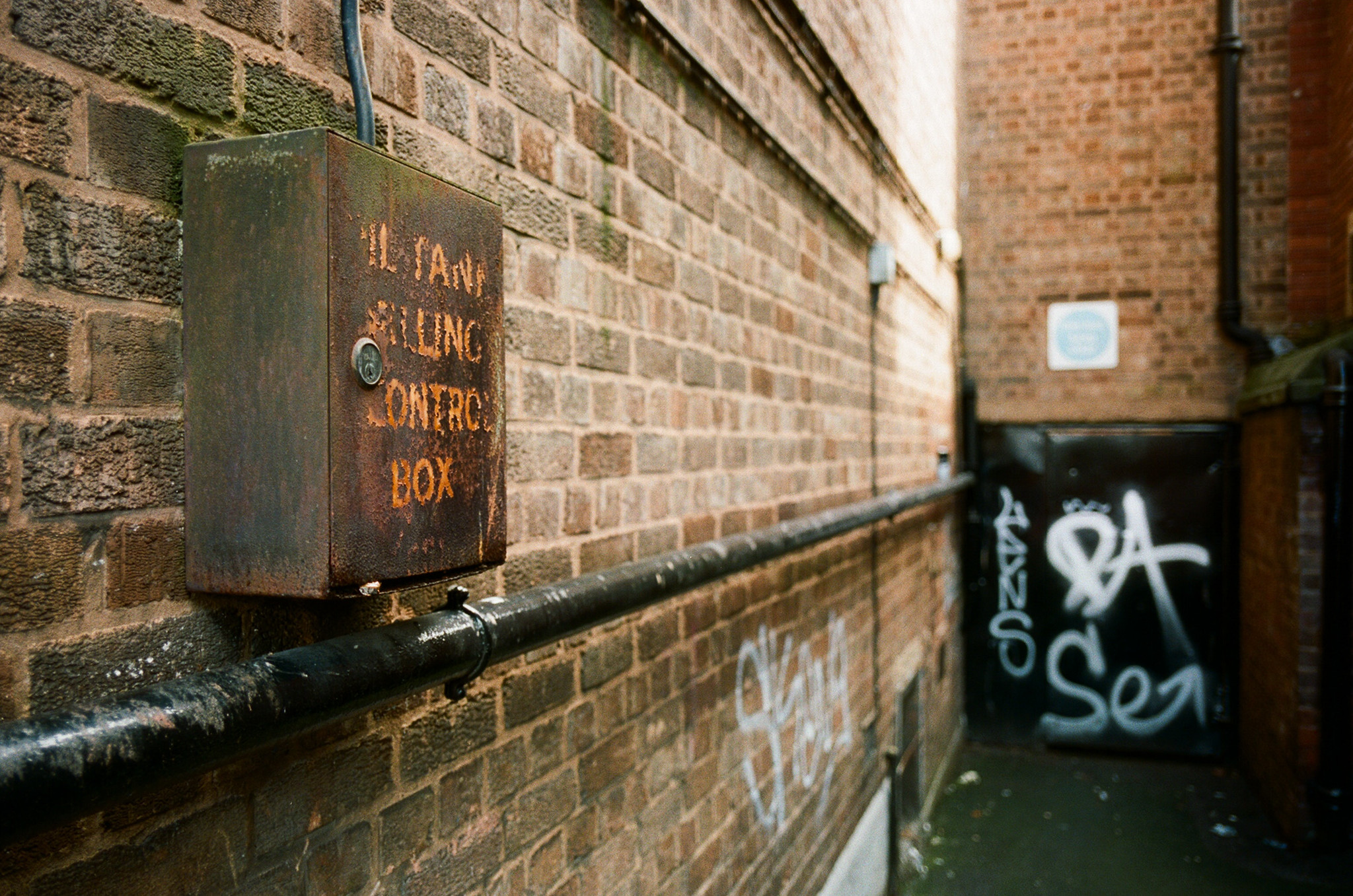I’ve gone off Leica glass – the newer stuff at least. I touched on this in a roundabout way in my 28mm Elmarit-M review, but since then it’s become ever more clear to me that it’s just not for me – it’s just too “good” for my tastes. This really couldn’t be truer of the Leica 90mm Elmarit-M, which is exactly why have just replaced it.
I’m not going to write some long protracted review about just how good the 90mm Elmarit-M lens is, there are plenty of reviews out there that extol it’s virtues much more eloquently than I’d be likely to. Instead, writing this post just feels like an opportunity to close a door on the world of modern Leica lenses behind me as I leave. The 90mm Elmarit-M was the last of my Leica lenses (apart from a thread mount 50mm Elmar), and now it’s gone, I can’t see me owning any lenses made by Leica since the 80’s.
This feels like quite a big thing for me as there was a time not all that long ago when I aspired to own a full set of Leica optics for my rangefinders, but now I can’t imagine that desire at all. They just don’t fit what I’m looking for from lenses – and recent experiences with the 90 Elmarit-m, when compared to another 90mm, have really sealed the deal on that opinion.
I’ve owned the 90mm Elmarit-m for a few years – 2 or 3 I think. In that whole time, my opinion of it as a lens has changed very little, if at all. What I want from a 90mm lens – and indeed any other focal length for that matter – has changed; or perhaps more accurately, it’s evolved. Over the last few years, my understanding of both the technical side of lenses and the photographic outcome they are likely to play a part in has grown significantly. Not only this, but my control over processes such as developing and scanning has increased dramatically. This has meant that I’m now able to better discern the impact of using different lenses on my work, especially in areas such as colour – which is something that I’ve previously found hard to grasp.
Finding the ZM Sonnar
Outside of the better control of my processes, I have quite a strong feeling that this all started with me discovering the Zeiss 50mm ZM Sonnar. You can read my extensive thoughts on that lens here, but the précis version for the sake of this post is that discovering that lens and the look it helped me produce in my images was a real turning point in my photography. I still like to play with other 50mm lenses (though these days, most are admittedly sonnars), but for the photography I shoot where I want to take advantage of a look I most like in my images, it’s the ZM Sonnar almost every time!

Finding Zeiss
After discovering the ZM Sonnar I wondered how much of the look I found it that lens was a Sonnar thing, and how much was a Zeiss thing. I came to some conclusions about this in my 28mm ZM Biogon post. Again, the précis version is that I felt that the primary identifiable traits of strong colour and contrast that combined to give a good sense of three-dimensionality was something that I appreciated in these lenses. I largely attributed these traits to the use of Zeiss coatings and declared myself a Zeiss fan, rather than just a Zeiss ZM Sonnar fan. I just find that the results I get from Zeiss lenses tend to have more of a look that fits with the feel I want to put across in my images – especially when it comes to rendition and vibrancy of colours.

Now, I’m the first to admit that there might be some confirmation bias at play here. As with anything subjective, it’s quite easy to convince yourself that your own perceptions prove what you want them to prove. But, a month or so ago I felt I had such strong proof to myself that I was right about this that I set the wheels in motion to replace the 90mm Elmarit-M with a lens that has the word “Zeiss” written on the front.
The 90mm Elmarit-M replacement
This all happened when I shot a roll with a Contax G2 and the 90mm 2.8 Sonnar. I don’t want to get into that story too much now, as I’d rather save it for the time at which I write more about that lens. But, to say the results from the Contax Sonnar blew me away in one roll would be an understatement.

This never happened with the Leica 90mm Elmarit-m. In fact, through the experience of shooting the 90mm Sonnar I’ve had a bit of a realisation about how I respond to lenses and how good a match I feel they are to me. I remember getting the first results back from the Elmarit-m. I thought they were impressive, very impressive, but rather than discerning this from an initial reaction based on the whole image, I remember quite vividly zooming in on the image in Lightroom to inspect how sharp the photo was. Very sharp was the answer, but beyond that, all I saw was a nice clean sharp image, nice bokeh, not much in the way of aberrations, distortion etc, just a nice high quality, quite neutral image.


Nothing really blew me away.
This is something that I found regularly throughout the time I owned the 90mm Elmarit-M. I never saw anything I didn’t like, but equally I never found myself enthralled by the photographic outcome either – at least without having to apply a heavier touch in Lightroom. As an example, there are a whole bunch of photos I took last time I went on holiday with the 90mm Elmarit-m.

This shot of a butterfly is a good example of one image I took whilst away. When I got home from holiday and put the images onto the computer I found a need to boost the colours, contrast and clarity. I’m happy with the end result, but the path to achieving wasn’t near as satisfying as scanning images from the Zeiss 90mm Sonnar and getting results like this with barely the slightest need for post-process.
It’s not just the 90mm’s fault
Looking back, I can see this opinion growing in me. Not so long ago there was the aforementioned 28mm Elmarit-M which I decided was probably the “best” lens I’d ever sold. And before that still, there was the first modern Leica lens I found myself nonplussed by the 50mm f2.5 Summarit-m. This was a lens Leica loaned me a few years ago along with the Leica M-A. Very nice lens too, but my conclusion was that actually, a used older Summicron gave results I preferred.
What’s interesting about my preference for the 50mm cron I was talking about then, and the 35mm I reviewed here and the 40mm ‘cron I reviewed here, is that they all come from a time when Leica were making lenses whose character was more heavily distinguishable in the results. Leica lenses from the 70’s and 80’s – which I believe to be the best of the lot – had a stronger reliance on higher lens contrast to give a sense of “sharpness”, they also had a slightly higher tendency towards flare. They were imperfect, and for that, I like them more.
Maybe I take boring photos?
Of course, all this might mean that I take boring photos that without some sort of lens based trickery to impart strong colours, vignettes or pretty flare don’t add up to much…? But, if that is the case, I’m not sure I care. To my mind, the lens – just as the film, the scanner, the printing technique, the software, etc – is a very important piece of the image-making puzzle. It just happens to be one of the most important pieces in my personal process.
Skip to the end
The point of all this waffle is this: the process of discovering the wonders of the 90mm Sonnar has confirmed to me (once again) that my desires for lenses sit outside of seeking optical “perfection”. The Elmarit-M is just too “perfect” a lens for my tastes – it doesn’t excite me like the Zeiss 90mm Sonnar does with its propensity for high contrast and overly strong colours and contrast.
But, whilst this does mean it’s not the lens for me, it’s more than possible that it doesn’t mean it’s not the ideal lens for you. If you’re looking for neutral, “sharp” images with good Bokeh; if you don’t like your lenses imposing themselves onto your final images, and if the words “character” and “lens” when combined give you a shiver like someone walked over your grave, then you should probably be reading this review by Mr. Rockwell instead. He thinks it’s a great lens – and as you’ve probably gathered I think he’s right too! But my name isn’t Ken… which in a roundabout way, is probably why I just sold my Leica 90mm Elmarit-M and had a 90mm Zeiss Sonnar converted to M-mount to replace it.
Keep an eye out for my forthcoming early impressions of my recently m-mount converted Zeiss 90mm f2.8 Sonnar…
Share this post:










Comments
Terry B on Leica 90mm f/2.8 Elmarit-M Review – closing the door on modern Leica lenses (in favour of Zeiss)
Comment posted: 10/06/2017
Hamish, an interesting little essay. I've highlighted the above sentence as it seems to encapsulate what you like about the Sonnar without considering visual sharpness, The overly strong colours comment seems to indicate that the Sonnar is far from neutral in its colour rendition. I'm a little nonplussed by this as you have indicated that you prefer the earlier Leica designs and which would not exhibit such a strong colour palette. Or do they, in your experience?
It seems as though you have conducted comparisons on your film and digital M's. Are these lenses behaving consistently i.e differently, over both platforms, in that you always prefer the Sonnar? I was wondering how much of the differences you were noting was down to this?
Comment posted: 10/06/2017
Robert Lai on Leica 90mm f/2.8 Elmarit-M Review – closing the door on modern Leica lenses (in favour of Zeiss)
Comment posted: 10/06/2017
I also agree that having some degree of aberration, as seen in the older lenses often gives them character and an interest to the image.
You could start your search all the way back to the beginning of Leica - the 90mm f/4 Elmar in screw mount, with uncoated optics.
It has tons of character, and the ladies will thank you for the flattering portrait rendition.
Nikon 85mm f/2 is one of the classic Sonnar designs that David Douglas Duncan discovered and made Nikon famous in the Korean War era.
Cosina Voigtlander's 90mm f/3.5 Apo Lanthar gives you a lot of vibrant colour without getting clinically sharp. It is tiny and light, also. Again, it comes in screw mount. Cosina builds most of the Zeiss branded lenses of today. I think this is one of Cosina's own designs.
Finally, I decided to try Leica's Macro Elmar M f/4. The idea of making a near focus lens (with near focusing adapter) with only 4 lens elements was too tempting to pass up. I'm doing a lot of hiking and nature photography lately. The Elmarit M feels like a brick to carry. The little Macro Elmar is much lighter. I've just acquired this lens, so I don't have any images with it yet.
My purpose was to mention that there are alternatives to modifying a Zeiss lens to fit the M mount. There are certainly many vintage and modern lenses that will give you a non-clinical rendition.
Comment posted: 10/06/2017
Terry B on Leica 90mm f/2.8 Elmarit-M Review – closing the door on modern Leica lenses (in favour of Zeiss)
Comment posted: 10/06/2017
Comment posted: 10/06/2017
Comment posted: 10/06/2017
Mike Hinkleman on Leica 90mm f/2.8 Elmarit-M Review – closing the door on modern Leica lenses (in favour of Zeiss)
Comment posted: 11/06/2017
Comment posted: 11/06/2017
rollbahn on Leica 90mm f/2.8 Elmarit-M Review – closing the door on modern Leica lenses (in favour of Zeiss)
Comment posted: 11/06/2017
I am not sure exactly what I like about the Type IV Cron but I just seem to love its colour and flaws out of everything I have tried. The ZM lenses are great but a little too much pop in the colour for my taste and far too stiff to focus but that's all very subjective and it's great we have the choices.
Comment posted: 11/06/2017
Rasmus on Leica 90mm f/2.8 Elmarit-M Review – closing the door on modern Leica lenses (in favour of Zeiss)
Comment posted: 11/06/2017
Comment posted: 11/06/2017
Roacoetuff on Leica 90mm f/2.8 Elmarit-M Review – closing the door on modern Leica lenses (in favour of Zeiss)
Comment posted: 21/06/2017
Comment posted: 21/06/2017
Mads Jaeger on Leica 90mm f/2.8 Elmarit-M Review – closing the door on modern Leica lenses (in favour of Zeiss)
Comment posted: 25/06/2017
John on Leica 90mm f/2.8 Elmarit-M Review – closing the door on modern Leica lenses (in favour of Zeiss)
Comment posted: 02/07/2017
Comment posted: 02/07/2017
Benson on Leica 90mm f/2.8 Elmarit-M Review – closing the door on modern Leica lenses (in favour of Zeiss)
Comment posted: 16/03/2018
Comment posted: 16/03/2018
George Quinn on Leica 90mm f/2.8 Elmarit-M Review – closing the door on modern Leica lenses (in favour of Zeiss)
Comment posted: 21/10/2018
stephen edmunds on Leica 90mm f/2.8 Elmarit-M Review – closing the door on modern Leica lenses (in favour of Zeiss)
Comment posted: 07/07/2019
Why not use the original lenses and enjoy their genuine character instead of artificially induced "character" lenses made by cosina who are a very modern company?
Comment posted: 07/07/2019